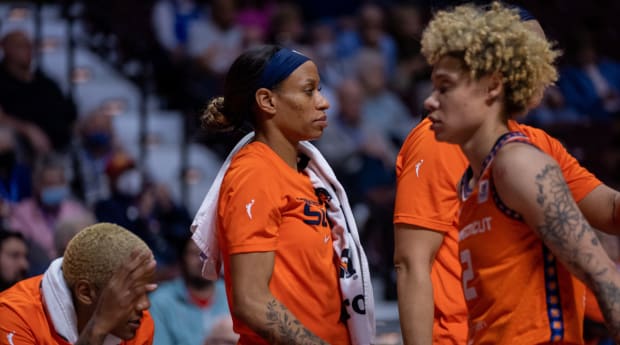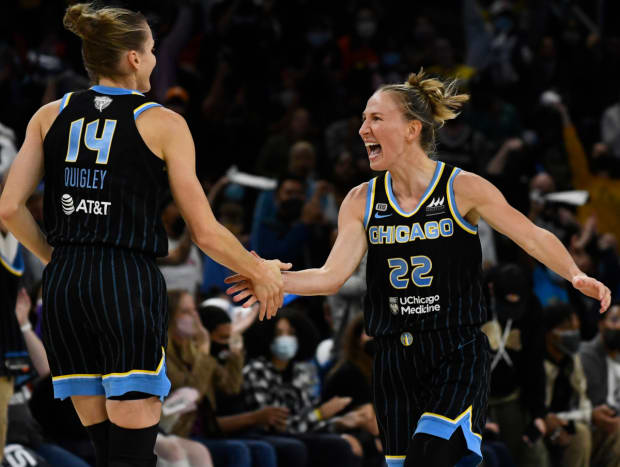When Jasmine Thomas was traded to the Sun in 2015, she had plans. She planned to avenge getting swept in the ’13 WNBA Finals with the Dream and not making it the year after. She planned to earn more minutes at guard and up her game, coming off the worst statistical season of her career. But Natisha Hiedeman’s showing up at training camp in ’19 was something Thomas hadn’t planned for.
“We got close playing the same position, spending a lot of time together and just became friends first,” Thomas says. “I got to know her as a person and just fell in love with who she was.”
Thomas and Hiedeman are one of three pairs of WNBA teammates who are publicly in a romantic relationship. The recently engaged couple, along with their Sun teammates Alyssa Thomas and DeWanna Bonner, and Chicago guards Courtney Vandersloot and Allie Quigley, all found love in the league and navigate the unique dynamics of balancing work and personal life while playing with their significant other.

Courtesy of Connecticut Sun
Across the board, players said they never thought they’d find their spouse in the workplace. Vandersloot not only didn’t plan for it, but for a while, she advocated against it.
“Obviously, if you break up, things get messy,” she says. “It's hard on other teammates, and that was something that was discussed really early on in our courtship. We never wanted to be a problem or a distraction to the team, so if it ever got to that point, it wouldn't be worth it for us.”
But when she and Quigley met at the start of the 2013 season in Chicago after playing on different teams in Slovakia months before, it just happened.
In the early stages, they kept their relationship under wraps. It was toward the end of the season and they knew they’d be going their separate ways in the offseason, so they wanted to be sure before involving the team.
Thomas said she and Hiedeman went through something similar.
“There was some hesitation because anytime you’re dating people in the workplace, it doesn’t matter what profession it is, there’s obviously some things that come with it,” she says. “You don’t want to mess up chemistry. You don't want to mess up anything that has to do with what's going on on the court.”
Eventually, though, the couples started telling people.
“Everybody knew, even though we thought that no one knew,” Quigley says.
Intrateam relationships aren’t new to the Sun’s Curt Miller. After 19 seasons as a head coach—13 at the Division I level and six with Connecticut—he said he’s had player relationships within the team in both stages of his career, and it’s something he’s learned to navigate.
“I think the best way is true transparency and honest and direct communication,” he says. “I will sit the couples down and tell them that I'm supportive and that I am really happy for them. All I ask is that when they come to work as professionals, they are true professionals, and they don't let anything affect the team that may be going on in their personal lives.”
Miller is one of the only openly gay male coaches in team sports, so for him, uplifting these relationships is a priority.
“It’s frustrating because I'm in a profession where that's not always the case in women's basketball,” he says. “Unfortunately, not all coaches are as receptive or accepting of relationships amongst the team. I just always thought that was very disappointing because now you have relationships that are being hidden, or they can't live authentically. They can't be true to themselves or their teammates.”
But the environment he’s created in Connecticut has allowed not only one couple, but two, to go public.
“He understands,” Hiedeman says. “Not only that, but he really takes pride in it. He is open and vocal and encourages other people to be their true self. I think that just makes it easier to play and be on a team where you can just truly be yourself.”
Miller says he’s only seen these relationships improve team chemistry.
“I'm a big believer that championships are won in the locker room before they're won on the court,” he says. “When you have some relationship dynamics within your team, you know that they already genuinely care and love each other. And that’s what you’re trying to build in that locker room.”
As the coach at Indiana and Bowling Green, he always emphasized the importance of spending time with your teammates off the court. He’s brought that approach to the WNBA and encourages the couples on his team to not isolate themselves and take part in those opportunities to bond with their other teammates.

Matt Marton/USA TODAY Sports
Vandersloot and Quigley have done the same in Chicago and took it upon themselves to create a family environment within the team where they don’t show any preferential treatment toward each other.
“We hold each other accountable just as much,” Vandersloot says. “My teammates will see me getting on Allie. She's not an exception. I think that helps, too, because they know that when we're on the court, it's business. We're about winning games and being the best we can be. … We're never going to be a distraction. We’re only going to be something that’s positive toward the team.”
Still, there are some challenges the couples have to navigate. Balancing work and home life while spending 24/7 with one another is the largest.
“There's days when couples arrive in separate cars or they're not sitting right next to each other at an airport gate, and you kind of turn your head and wonder, How is everything going?” Miller says.
Thomas and Hiedeman consider themselves to be opposites. Hiedeman is the laidback one, while Thomas always likes to be busy and plan out her schedule. By acknowledging these differences, they maintain a balance and make it work.
“I feel like she definitely needs a break from me sometimes even though she won't admit it,” Thomas says. “She wants to be laid up watching Netflix, and I know sometimes I need a break from that, too.”
Quigley says she and Vandersloot have come to understand that balance, as well.
“You know when you need time apart, and you know when you're just going to stay with each other for 24 hours a day,” she says. “Like any other relationship, you learn each other and you know what each other needs.”
Some couples who work together may make a conscious effort to keep their work and home lives separate, but the Vanderquigs haven’t had to.
“We both are obsessed with basketball, so we’re O.K. with talking about it at home,” Quigley says. “We've figured out how to navigate that.”
The other biggest challenge for couples in the league comes at contract time. After winning a title last season, Quigley and Vandersloot were both free agents this offseason and had a difficult decision to make about their future in Chicago.
“We knew this free agency would be tough trying to navigate what’s best for us both,” Quigley says. “We communicated, had many conversations and ultimately made the best decision for us.”
After having those tough conversations, the Vanderquigs both re-signed with the Sky for one year.
Couples face similar challenges with other big career decisions, like playing overseas. Being teammates is the easy part, especially for Thomas and Hiedeman, who spend the offseason in different countries.
“We have to spend so much time apart, and it's tough on a relationship,” Thomas says. “Being able to be teammates in the summer helps because we know that we’re going to be back together.”
This offseason, Hiedeman had the opportunity to play in Russia, which is known as one of the most difficult countries to play in because of the language barrier, weather, time difference and now the ongoing war with Ukraine that has caused many WNBA players to leave the country altogether. But after discussing it with Thomas, she couldn’t pass up the opportunity.
“When I was talking with Jas about it, she was just really encouraging me to do it because it’s a great basketball opportunity,” Hiedeman says. “When it comes to decisions like that, we're really just focused on what’s best for one another—not putting our relationships second, but we want what’s best for each other first.”
The two Sun players have a seven-year age gap, which Thomas says allows them to make tough decisions.
“I’ve been through it,” she says. “I know what’s ahead of her. I know the type of career that she's headed to have, that she’s going to be all over the place as long as she wants to do it. I get that. That doesn’t scare me. I love that part of the grind. I try to be there for her to advise her. But also me being at the end of my career allows us to prepare for the next step of our life—getting married, having kids.”
Even if there have been intrateam relationships around the WNBA for the last 25 years, the openness that players are showing now signals a changing dynamic in the league.
“Like with many things, the W is at the forefront of embracing social issues,” Thomas says. “You're seeing women that are powerful and influential living their truth and sharing it loudly. Before, that wasn't acceptable, that wasn't embraced, and you didn't feel that safe space.”
Miller believes that’s largely due to a change of heart from those at the top.
“I think there's been a lot of maturity and growth through ownership and through people that sit in positions of power,” he says. “We feel the support from the top of the organization that we can truly live authentically. And we model that in Connecticut from the top down.”
There’s still plenty of room for growth when it comes to accepting LGBTQ+ relationships in sports, but the players say the support they’ve felt from their teams and fan bases outweighs any backlash they’ve received.
“Having games specifically for the LGBTQ community and hearing the stories from our fans that are also in the LGBTQ community, just telling us how much our relationship has meant to them is something we’re lucky to be a part of,” Quigley says. “Sometimes we don’t realize how much progress has been made.”
While dating a teammate may be unconventional in most leagues, it’s allowed some WNBA teams to form an even stronger bond while allowing these players to share the game they love with the person they love most.
“Professional sports, in general, can be a lonely path, especially in the WNBA if you’re playing overseas,” Vandersloot says. “To have somebody that understands what you’re going through, but also can be there with you, it definitely makes the journey different and more enjoyable and special. I think finding that connection is inevitable.”







